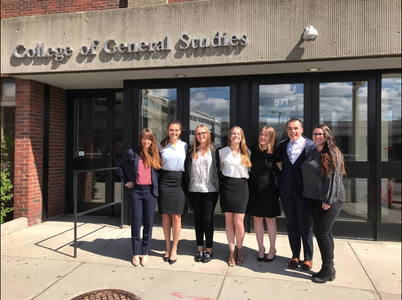Preventing Brain Trauma in Youth Football Players
Capstone Team Proposes Solutions to the NFL’s Brain Trauma Problem
Sara Mannes (CGS’17, CAS’19) says her CGS Capstone project has made watching sports a little uncomfortable. “I used to appreciate professional sports because of their high-intensity, high-impact nature, and I would even cheer when someone was tackled or hit,” she said. “Now it is hard for me to watch knowing what is at stake.”
Last week, Boston University’s Chronic Traumatic Encephalopathy Center (CTE Center) published research—covered far and wide in the New York Times, Boston Globe, NBC, CNN, PBS, and more—showing just what’s at stake. The Center found CTE in 99 percent of brains obtained from NFL players, in 91 percent of college football players, and in 21 percent of high school football players. CTE is a progressive degenerative brain disease found in people with a history of repetitive brain trauma. BU’s researchers found dangerous symptoms even in mild cases: depression, anxiety, disinhibition, memory loss, and other mood and behavior impairments.

Several months before the research findings were published, Mannes and a team of CGS students studied this topic intensely for their Capstone project, with the help of the CTE Center. The team had their choice of 23 Capstone topics and voted to focus on this one. “I’m so glad we decided on this topic because learning more about the dangers of concussions at all levels of football was definitely an eye-opening experience,” said Steven Silvio (CGS’17, COM’19).
The team interviewed researchers from the CTE Center and were able to see documents, journals and even images and diagrams from deceased NFL players. Those interviews prompted new discoveries and insights. Emma Johnson (CGS’17, COM’19) said, “It made us truly question why there aren’t more CTE Centers across the US, especially at universities where football is the biggest and main sport. Centers just like the one at BU should be sprouting up everywhere, and they’re not because people turn a blind eye to this subject.”
Amanda Brancato (CGS’17, COM’19) said the center’s research made the group wonder, “Is CTE an issue exclusive to the NFL? Are we putting our children in danger or at a greater risk by beginning tackle football at such young ages, where the most critical brain development takes place?”
These questions prompted the team to find a solution for CTE by focusing on prevention and education at the youth level. The students proposed more research on youth brain development, better education about the dangers of repetitive hits to the head, and a ban on tackle football at the high school level. For insights into the last proposal, the team interviewed Somerville Mayor Joe Curtatone, who ended the city’s youth tackle football league and created a flag football league instead.
All Capstone projects are interdisciplinary, so the finished 51-page paper included cultural analysis on masculinity and the role it plays in the problem. Silvio said this part of the research was the most eye-opening to him. Players stay in the game, even when they’re injured, so they don’t look weak and so they can keep their starting spots. Samantha Faden (CGS’17, SAR’19) was surprised that the NFL covered up the problem instead of working to educate and protect players: “This exposes larger problems at stake within the NFL, and in the sport of football as a whole.”
Football’s cultural role definitely plays a part, Brancato says: “Football is a symbol of athleticism, manhood, strength, and the American Dream. Nobody wants to admit that the sport they love and adore is causing premature deaths in their favorite players.”
Mannes says the team became very invested in the topic and they’re glad to see it getting the publicity it deserves. She hopes the new research findings will save lives, says, but as the team learned, “It is not easy to nail down a clear solution to this problem. There is still a long way to go.”